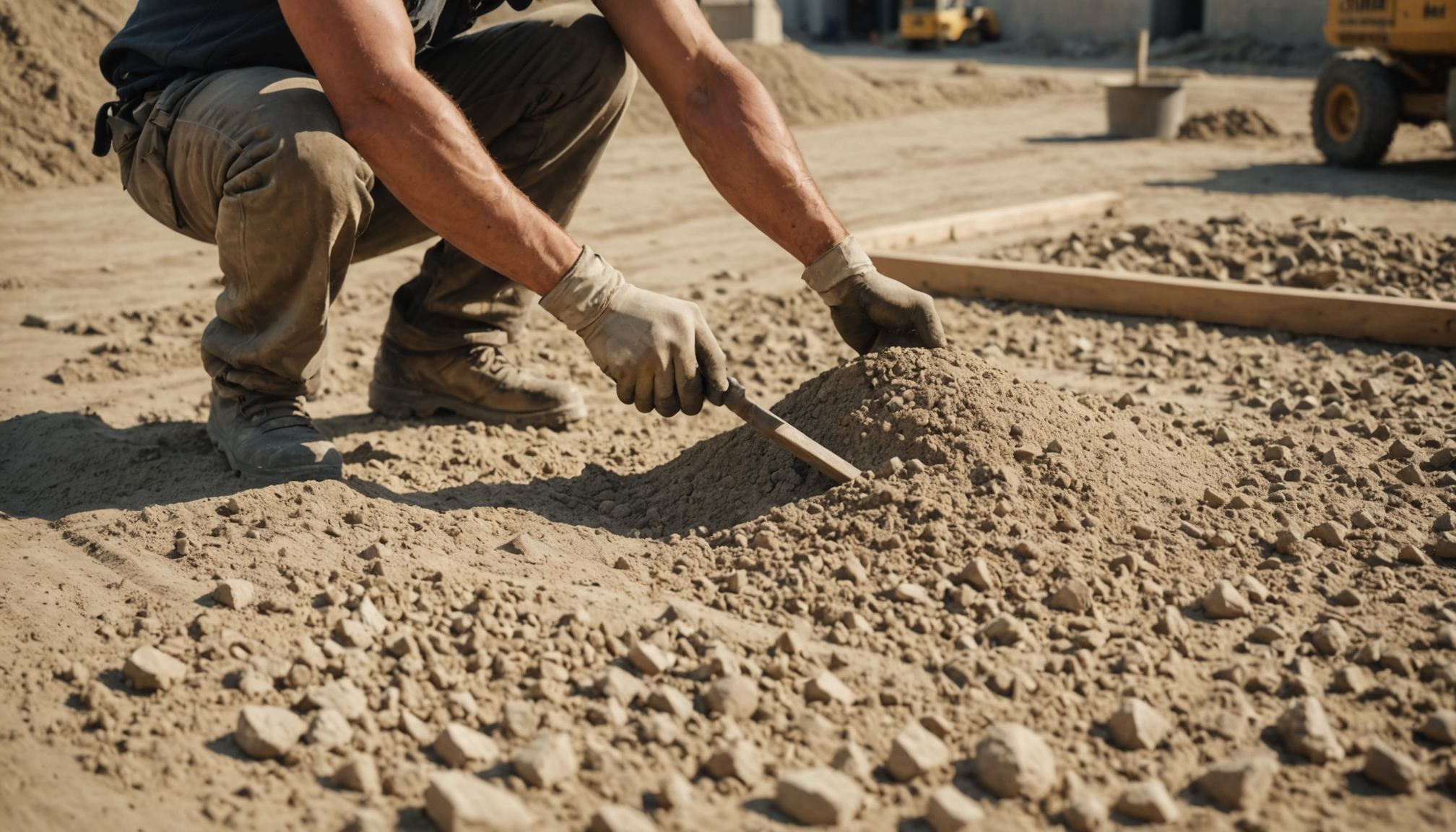Choosing the right concrete mix is a critical step in preventing cracks and ensuring the longevity of your concrete structures. By selecting the appropriate mix, you can significantly reduce the likelihood of structural issues and enhance the durability of your project. The suitability of a concrete mix largely depends on its intended use, the environmental conditions, and the specific performance criteria required for the job.
A well-chosen concrete mix provides the ideal balance of strength and workability. To make an informed decision, consider the following components and factors: cement type, aggregates, water-cement ratio, and the inclusion of admixtures.
- Cement Type: The type of cement used plays a crucial role in the strength and setting time of the concrete. Ordinary Portland Cement (OPC) is commonly used for general construction, while specialized types like Sulfate Resistant Cement and Pozzolanic Cement offer additional benefits under certain conditions.
- Aggregates: Concrete aggregates are categorized into fine and coarse types. Fine aggregates, like sand, enhance the mix’s workability and finish. Coarse aggregates, such as gravel or crushed stone, provide volume and strength. Selecting the right size and type of aggregate can improve the concrete’s performance and reduce cracking.
- Water-Cement Ratio: The ratio of water to cement in the mix is a vital determinant of the concrete’s strength and durability. A lower water-cement ratio usually results in higher strength and reduced permeability, which helps mitigate the risk of cracking. However, too low a ratio can lead to difficulties in working with the mix, affecting the final finish.
- Admixtures: These are added to modify the properties of the concrete mix. Common admixtures include plasticizers, which enhance workability, and air-entraining agents that improve freeze-thaw durability. Other specialized admixtures can improve specific characteristics, such as accelerating or retarding the setting time, based on the environmental conditions.
To assist in the decision-making process, the table below provides a comparison of different concrete mixes and their primary attributes, showcasing their suitability for various applications:
| Mix Type | Strength (psi) | Primary Use | Advantages | Considerations |
| Standard Mix (1:2:4) | 3000-5000 | Residential buildings, non-critical structures | Cost-effective, readily available | Limited resistance to aggressive environments |
| High-Performance Mix | 6000+ | Bridges, skyscrapers, structural elements | High strength, durability, resistance to environmental damage | Higher cost, requires specialized handling |
| Waterproof Mix | 4000-5000 | Basements, retaining walls | Excellent moisture resistance | May require sealants for maximum efficiency |
By understanding the intricacies of different concrete mixes and their applications, you can more effectively prevent cracks and ensure the success of your construction projects. Tailor your selection to the specific requirements and conditions of your site to achieve the best results, emphasizing a proactive approach to building quality and sustainability into your projects from the ground up.
proper site preparation
Proper site preparation is an essential part of ensuring the longevity and integrity of your concrete structure, as it lays the foundation for a crack-free surface. Follow these steps to prepare your site effectively:
- Surveying and Planning: Begin by surveying the site to understand its contours and identify any potential challenges, such as slopes or drainage issues. Create a detailed plan outlining the dimensions, elevation, and orientation of the concrete structure. Proper planning helps prevent issues like pooling water, which can lead to cracking.
- Clearing the Site: Remove all vegetation, debris, and any obstructions from the area where the concrete will be poured. This includes eliminating tree roots, grass, rocks, and old concrete that could compromise the integrity of the new pour.
- Compacting the Soil: Use a mechanical compactor to compact the subgrade soil thoroughly. Proper compaction helps reduce the risk of settling after the concrete has been poured, a common cause of cracking. Aim for uniform compaction across the entire area to ensure even support for the slab.
- Ensuring Proper Drainage: Make sure the site is graded to direct water away from the foundation or base of the concrete slab. This may involve creating a slight slope or installing drainage systems to prevent water accumulation beneath the concrete, which can cause cracks.
- Setting Up Forms: Install sturdy and level forms to define the shape of the concrete pour. Forms are typically made from wood, metal, or plastic, and must be accurately positioned to match the layout plan. They should be securely staked into the ground to prevent movement during the pour.
- Adding a Base Layer: Lay down a base layer of compacted gravel or crushed stone, approximately four inches thick, to improve drainage and provide additional support. This helps to distribute loads more evenly and minimizes the potential for cracking due to ground moisture or movement.
- Applying a Vapor Barrier: If the concrete will be in contact with the earth, consider installing a moisture barrier, such as a polyethylene sheet, over the base layer. This prevents moisture from seeping up into the concrete, which can lead to efflorescence or weakening of the structure.
- Reinforcing the Concrete: Place reinforcing bars (rebar) or wire mesh over the area, suspended above the surface. Make sure the reinforcement is properly positioned using spacers to ensure it remains within the slab during the pour. Reinforcement provides tensile strength to the concrete, further reducing the risk of cracking.
By meticulously preparing the site, you set the stage for a durable, crack-resistant concrete structure. Attention to detail at this stage can save time, money, and effort related to repairs or replacements in the future.
effective curing techniques
Effective curing is a critical phase in concrete installation, substantially impacting the final strength and durability of the concrete structure. This crucial process occurs after the concrete pour and involves maintaining adequate moisture, temperature, and time parameters to allow the concrete to fully develop its properties. Properly cured concrete exhibits enhanced structural integrity and significantly reduced incidence of cracking, thus prolonging the lifespan of the construction.
Firstly, ensuring that the concrete retains sufficient moisture during the curing period is essential. Concrete naturally tends to lose moisture as it sets, which can lead to premature drying and consequently, cracking. Different methods are employed to keep the concrete moist. One common technique involves water curing, where the surface is kept continuously wet by ponding or misting. Covering the concrete with damp burlap or cotton mats can also be effective, ensuring a consistent moisture presence throughout the curing phase.
Alternatively, curing compounds provide another excellent method by forming a sealing film on the concrete surface that retains water within the mix. These compounds are applied immediately after finishing and act as a barrier to water evaporation, which is crucial in drier climates or where water resources are limited. Opting for a curing compound also reduces labor intensity and requires less frequent maintenance compared to traditional water methods.
Temperature control is another vital component. The curing process relies on hydration, a chemical reaction that requires specific temperature ranges to proceed effectively. Concrete should ideally cure at temperatures between 50°F and 75°F. If the concrete is exposed to temperatures outside this range, its strength and surface finish could suffer. In colder climates, it might be necessary to use insulated blankets or heated enclosures to maintain optimal temperature conditions. During hot weather, sunshades or windbreaks can help to regulate temperature and prevent rapid moisture loss.
Time also plays a crucial role in the curing procedure. Typically, concrete reaches about 70% of its full strength within the first seven days, but prolonged curing is highly beneficial. Extending the curing period for up to 28 days allows additional hydration, boosting the concrete’s final properties. The timing can be adjusted based on the ambient conditions and the specific mix used, underscoring the importance of a tailored approach.
Strict adherence to effective curing techniques results in concrete that withstands mechanical stresses better and demonstrates superior long-term performance. By ensuring that the hydration process is neither rushed nor interrupted, you’re laying the groundwork for a resilient, crack-free surface that requires less maintenance over its life cycle. Investing the time and resources into proper curing techniques pays dividends in the form of stronger, more durable concrete structures.
controlling moisture levels
Managing moisture levels is crucial in preventing cracks in concrete, as both excess and insufficient moisture can compromise the integrity of the structure. Understanding how to control and monitor moisture levels effectively can significantly enhance the longevity and durability of your concrete projects.
Maintaining the proper moisture content in the concrete mix itself is the first step. During mixing, accurately measure the water-cement ratio and ensure that it is appropriate for the specific type of concrete being used. The balance here is key; too much water can lead to excessive shrinkage, while too little can make the mix unworkable and weak. Additionally, consider using admixtures that enhance moisture retention without affecting the basic properties of the concrete mix.
Environmental factors play a significant role in moisture management. Before the concrete is poured, assess the surrounding conditions, including humidity and temperature, as these can influence the rate at which moisture is lost from the concrete. High temperatures and windy environments can accelerate evaporation, leading to rapid drying and increased shrinkage, resulting in cracks. It is essential to devise strategies to mitigate these environmental effects, such as using windbreaks or temporary coverings to shield the curing concrete from harsh conditions.
Once the concrete is in place, it is equally important to prevent excess moisture infiltration, especially from the ground. The use of a vapor barrier, as discussed in site preparation steps, prevents underlying moisture from migrating into the concrete slab, which can weaken it over time. Similarly, sealants can be applied to the surface to act as an additional layer of protection against moisture ingress. These sealants should be reapplied according to manufacturer instructions to maintain their effectiveness, particularly in areas prone to heavy rainfall or high humidity.
Regular monitoring throughout the curing process is necessary to ensure that moisture levels remain within optimal ranges. This may involve checking for consistency in color and finish, which can indicate uniform moisture distribution and successful curing. Employ devices that measure relative humidity in and around the concrete to detect any fluctuations that could lead to undesirable moisture conditions.
In the long term, controlling the drainage around the concrete structure is pivotal. Ensure the surrounding terrain slopes away from the concrete, directing water runoff to an appropriate drainage system. By doing so, you prevent pooling and reduce the risk of moisture-related stress at the edges of the concrete, which is where cracks commonly begin. Additionally, inspect the surface regularly for signs of water accumulation and address drainage issues promptly to avert water damage.
By focusing on moisture management, not only can you prevent the formation of cracks, but you also enhance the overall quality and durability of the concrete. Integrating these strategies into your concrete projects will help you maintain structural integrity and reduce the need for costly repairs and maintenance, leading to more reliable and enduring results.
regular maintenance practices
To ensure the longevity and durability of your concrete structures, integrating regular maintenance practices is essential. Routine inspections serve as a proactive strategy to identify potential cracks or weaknesses before they escalate into significant issues. Schedule regular checks of your concrete surfaces, especially in areas exposed to heavy traffic or extreme weather conditions. Look for early signs of cracking, discoloration, or uneven settling, and address them promptly to mitigate further damage.
Sealing concrete surfaces at recommended intervals is crucial in protecting against moisture absorption and chemical damage. High-performance sealants fill the microscopic pores within the concrete, preventing water, salts, and other harmful substances from penetrating and causing damage. Depending on the traffic and exposure the concrete faces, reapply sealants every few years to maintain a protective barrier and enhance the structure’s longevity.
For outdoor concrete surfaces, seasonal care is vital in combating the effects of weather fluctuations. During winter, avoid using deicing salts, which can severely damage concrete. Instead, opt for sand or cat litter to provide traction. In hot weather conditions, regularly wet down concrete driveways and walkways to prevent extreme temperature variations that cause expansion and contraction, inevitably leading to surface cracks.
Resurfacing is an effective maintenance measure for older concrete that has started to develop imperfections or shallow cracks. By applying a thin overlay, you not only refresh the appearance of your concrete but also prolong its life by minimizing the expansion of existing cracks. This overlay bonds with the existing surface to provide a rejuvenated finish and added protection.
Taking care of the landscape surrounding your concrete structures also plays a part in maintenance. Ensure that trees and plants with extensive root systems are planted a safe distance from concrete slabs. Roots can exert pressure, causing cracks over time. Additionally, maintain proper grading and drainage around the concrete to steer water away and prevent undermining the foundation.
Lastly, implement a cleaning routine to remove dirt, debris, and potentially harmful substances that accumulate over time. Use a gentle cleaning agent and a pressure washer set at a safe distance to protect the surface integrity. Regular cleaning not only helps in aesthetics but also prevents the development of conditions that could lead to structural deterioration.
By incorporating these regular maintenance practices, you can significantly extend the life of your concrete structures, keeping them sturdy and visually appealing for years to come. Establishing a habit of vigilant upkeep ensures that minor issues are addressed before they turn into more serious, costly repairs.
—
In conclusion, protecting the longevity of your concrete structures requires a comprehensive approach that combines choosing the right mix, rigorous site preparation, effective curing, meticulous moisture control, and diligent maintenance practices. Each of these steps plays a pivotal role in preventing cracks and ensuring that your concrete remains strong and durable over its lifetime. By investing time and effort into each phase of your concrete project, you’ll find that the results are not only resilient but also aesthetically pleasing, providing peace of mind and lasting value to your investment.


